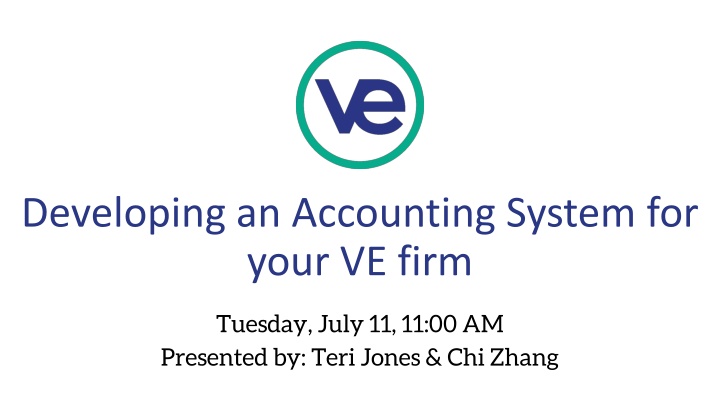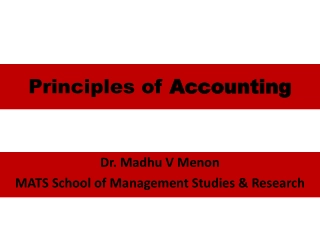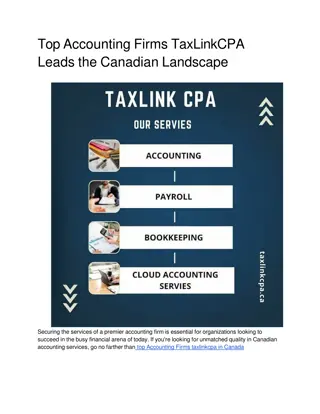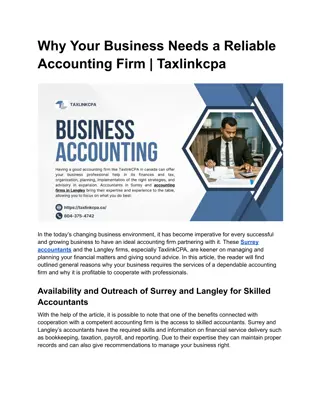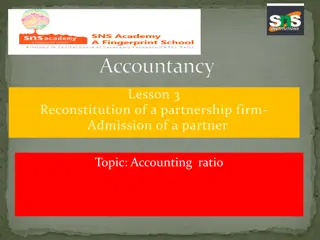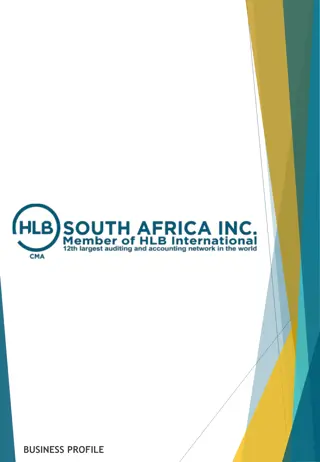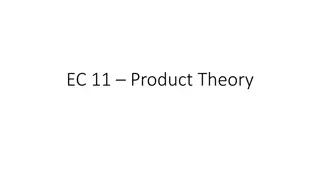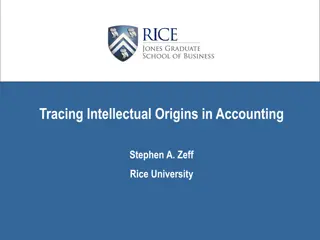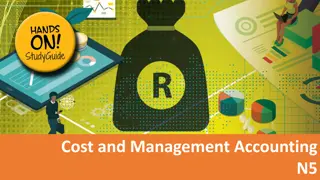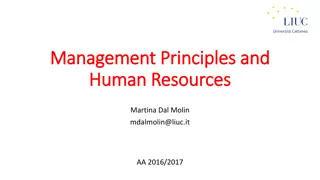An Accounting System for Your VE Firm
Presented by Teri Jones & Chi Zhang, this session covers a comprehensive agenda including accounting journals, cash budgeting, projections, income statements, financing, and more to help your virtual enterprise firm manage finances effectively.
Uploaded on Mar 20, 2025 | 1 Views
Download Presentation

Please find below an Image/Link to download the presentation.
The content on the website is provided AS IS for your information and personal use only. It may not be sold, licensed, or shared on other websites without obtaining consent from the author.If you encounter any issues during the download, it is possible that the publisher has removed the file from their server.
You are allowed to download the files provided on this website for personal or commercial use, subject to the condition that they are used lawfully. All files are the property of their respective owners.
The content on the website is provided AS IS for your information and personal use only. It may not be sold, licensed, or shared on other websites without obtaining consent from the author.
E N D
Presentation Transcript
Developing an Accounting System for your VE firm Tuesday, July 11, 11:00 AM Presented by: Teri Jones & Chi Zhang
Agenda Accounting Journals (Reference Files, Accounting Journals) Cash Budget (Task 1 & 2) Making Projections Income Statement Financing the Business Balance Sheet Cash vs. Accrual Basis Beginning of the Year Financing
Journals WHY? To keep more accurate records WHAT? A system with checks and balances to help avoid mistakes Cash Receipts and Payments Journal Sales Journal Purchases Journal Inventory Record Payroll Register Loan Payment Table Found on the Portal / Accounting & Finance / Reference Files
WHY? To determine if cash balance is sufficient for operations. Cash WHAT? Basic Sections of Financial Statement are: Beginning Balance, cash in, cash out, ending balance Task: Cash Receipts and Payments Prepare a record of all money coming in and going out of the bank account Itemized by type (See Cash Budget )
Cash Budget Description Cash balance at beginning of period: Receipts of cash: Sales Receipts of accounts receivable Loan proceeds Other Total receipts Beginning balance + cash receipts Payments: Cost of merchandise Salaries Accounts payable Rent Advertising/ promotion Payroll tax Insurance Accounting and legal fees Utilities Loan Payment Pension, 401(k) Freight out Sales tax Other or miscellaneous Corporate tax Total payments Cash balance at end of period Net increase or decrease in cash FY 2016-2017 TOTALS 0 0 (wholesale marketplace) (net pay on payroll register) (regional office) (other VEI firms) (from payroll register & 941 form) (other VEI firms or regional office) (other VEI firms or regional office) (other VEI firms or regional office) (loan payment table) (from payroll register + emp. cont.) (have you researched shipping fees?) VEI Sales Tax is 7% of sales (Nationally) (paid at the end of the year) 0 0 0
Projections WHY? To estimate profit, cash needs WHAT? A realistic, researched, educated guess Budget/Expenses Monthly Expenses Rent/Payroll/Utilities One-time expenses Furniture/Equipment/Initial Inventory Sales Projections (Sales & Marketing/Reference Files) Break-Even Analysis COGS Profit/Loss (Income Statement)
Income Statement For the period May 1, 2016 April 30, 2017 Revenue Cost of Goods Sold Gross Profit Total Operating Expenses Provide details Income from Operations Corporate Tax Net Income After tax Statement of Earnings What is your projected revenue? Projected operating expenses? How much profit or loss does your firm project to have this year? - - GROSS MARGIN %: Gross Profit/ Revenue = Gross Margin The % of revenue that you keep after COGS. - PROFIT MARGIN %: Net Income/Revenue = Profit Margin The % of revenue that you keep after all expenses and taxes.
Income Statements Fiscal Year by Month = Year End & Projections
Financing the Enterprise WHY? To assure enough cash is on hand for successful operations WHAT? Borrowing money or increasing owner s equity (or out-of- network sales for VE) Debt vs. Equity Financing Non-VE Sales The Balance Sheet COMPLETE THE BUSINESS REGISTRATION FORM TO APPLY FOR STARTUP FUNDING VE PORTAL / SUBMITTAL FORMS
Finance Beginning of the Year Business Registration Form Startup Budget Worksheet Monthly expenses & One-time expenses Seed Money All new firms receive $20,000 in seed funding from the VE National Office in exchange for 2,000 shares of company stock ($10 par value per share). Create Initial Balance Sheet Additional Cash to Support Operations Use Capital Needs Flowchart & Fulfill requirements and Submit request As the Year Continues: Update Balance Sheet Manage the Bank Account Monitor and Record Cash Received Make and Record Cash Payments
Balance Sheet WHY? To Show Owner s Equity WHAT? Uses the Accounting Equation: Assets = Liabilities + Shareholders Equity LIABILITIES + = ASSETS SHAREHOLDER S EQUITY http://prezi.com/4b0mpbgw-ccx/the-balance-sheet/?utm_campaign=share&utm_medium=copy
How Does Equity Grow (or shrink)? What will happen to your assets (cash, inventory, equipment) over the course of the year? How to show changes in equity? Retained Earnings Assets = Liabilities + (Shareholders Equity + Retained Earnings) Retained Earnings = Assets - Liabilities - Shareholders Equity
Balance Sheet: Accounting & Finance/Reference Files/Financial Statement Templates with Explanations
Cash vs. Accrual Accounting WHAT? Using accounting that will either log records according to when the cash is spent or received (CASH BASIS) or According to when the expense/income was incurred (ACCRUAL BASIS). WHY? 1. One is easier (Cash) and one more accurate for the time period (Accrual) 2. Once a company chooses either Cash or Accrual system, there is no changing.
Cash vs. Accrual Accrual Income Statement Cash Cash Budget When the transaction takes place or when a service is used When the money is received or paid Month 1 2 3 Month 1 2 3 Revenues Receipts Internet Sales 2,000 2,000 2,00 0 Cash Receipts 1,500 0 3,500 Expenses Payments Insurance 1,000/12 1,000/12 Insurance 1,000 0 0 Utilities 4,750/12 4,750/12 Utilities 4,750/8 4,750/8 Utilities= $4,750 for 12 months of use, payable in 8 monthly installments For another explanation, visit the Khan Academy: https://www.khanacademy.org/economics-finance-domain/core-finance/accounting-and-financial- stateme
Review: General accounting practices in VE Prepare a budget Keep records of all transactions o Using the accounting journals Oversight & Internal Controls Using the Webinars Using the journals to prepare & Update financial statements o Cash Budget o Income Statement o Balance Sheet Year-end reporting in the Annual Report
ACTIVITY: Using the Accounting Journals Go to: portal.veinternational.org 1. Accounting & Finance/task 1 & 2 2. Reference Files/Payroll Register (or with instructions) 3. Videos/Basics of the Accounting Journals/Reference Files/Payroll #1
Engage Various Company Departments: Cash Payments and Receipts Journal (Finance Dept.) Payroll Register (w/ HR Dept.) Sales Journal (w/ Sales & Marketing) Keep Good Records: Purchases Journal Inventory Log Asset Log Loan Payment Table
Financial Statements Cash Flow Statement Income Statement Balance Sheet Break-Even Analysis (for Business Plan)
